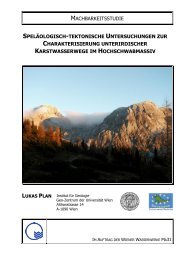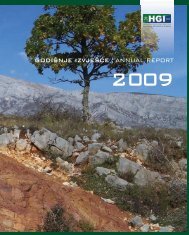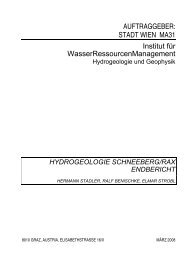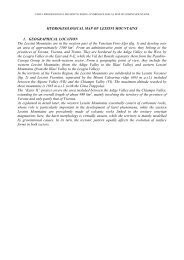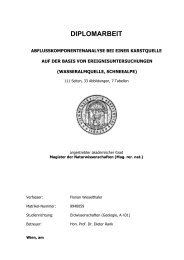Explanatory notes to the digital geological map of the Rax ... - KATER
Explanatory notes to the digital geological map of the Rax ... - KATER
Explanatory notes to the digital geological map of the Rax ... - KATER
You also want an ePaper? Increase the reach of your titles
YUMPU automatically turns print PDFs into web optimized ePapers that Google loves.
<strong>KATER</strong> II Geology <strong>of</strong> <strong>the</strong> <strong>Rax</strong>-Schneeberg-region<br />
__________________________________________________________________________________________<br />
2.2 Structural frame <strong>of</strong> <strong>the</strong> <strong>Rax</strong>/Schneeberg aquifer system<br />
The karstified plateau mountains <strong>of</strong> <strong>Rax</strong> and Schneeberg are forming <strong>the</strong> catchment areas <strong>of</strong><br />
several springs <strong>of</strong> <strong>the</strong> Vienna Water Supply, for example <strong>the</strong> Kaiserbrunn-, Hölltal, Fronbachand<br />
Stixenstein spring.<br />
The aquifer is mainly built by Middle <strong>to</strong> Early Upper Triassic carbonate rocks <strong>of</strong> shallow water<br />
origin – <strong>the</strong> Gutenstein, Steinalm and Wetterstein limes<strong>to</strong>nes and dolomites. Limes<strong>to</strong>nes<br />
from slope <strong>to</strong> basinal depositional sites – <strong>the</strong> Grafensteig limes<strong>to</strong>nes – are <strong>of</strong> some relevance<br />
only in <strong>the</strong> nor<strong>the</strong>rn Schneeberg area, see stratigraphic scheme Figs. 2 and 3.<br />
SCHNEEBERG NAPPE<br />
During <strong>the</strong> alpine tec<strong>to</strong>nics this Wetterstein platform was detached from its basement and<br />
from adjacent basinal carbonate rocks and became a tec<strong>to</strong>nically isolated mass <strong>of</strong> rocks, <strong>the</strong><br />
Schneeberg Nappe.<br />
The Lower Triassic Werfen Formation, which may act as an aquitard or aquiclude, was used<br />
as a shear horizon during <strong>the</strong> nappe movements. Therefore only parts <strong>of</strong> it remained in <strong>the</strong><br />
stratigraphic succession <strong>of</strong> <strong>the</strong> Schneeberg Nappe, large parts got lost during thrusting. We<br />
cannot expect it anymore as a continous layer below <strong>the</strong> carbonates.<br />
The lateral boundaries <strong>of</strong> <strong>the</strong> Schneeberg Nappe can be drawn <strong>to</strong>day without any doubt:<br />
On <strong>the</strong> nor<strong>the</strong>rn side <strong>the</strong> Triassic rocks <strong>of</strong> <strong>the</strong> Schneeberg Nappe are thrusted over Early <strong>to</strong><br />
Middle Jurassic basinal sediments <strong>of</strong> <strong>the</strong> Göller Nappe. The same situation is visible within<br />
two tec<strong>to</strong>nic windows, <strong>the</strong> Ödenh<strong>of</strong>- and <strong>the</strong> Hengst-Window.<br />
On <strong>the</strong> western side <strong>the</strong> tec<strong>to</strong>nic contact shows two different situations. In <strong>the</strong> nor<strong>the</strong>rn part<br />
<strong>the</strong> Schneeberg Nappe again superimposes Middle Jurassic basinal sediments <strong>of</strong> <strong>the</strong> Göller<br />
Nappe. In <strong>the</strong> sou<strong>the</strong>rn part Middle Triassic <strong>to</strong> Carnian rocks <strong>of</strong> <strong>the</strong> Schneealpe (Mürzalpen<br />
Nappe) are dipping down <strong>to</strong>ward east below <strong>the</strong> Schneeberg nappe.<br />
On its sou<strong>the</strong>rn side <strong>the</strong>re is an overthrust contact <strong>to</strong> <strong>the</strong> Palaeozoic <strong>to</strong> Lower Triassic<br />
shales and siliciclastics <strong>of</strong> <strong>the</strong> underlying Werfen Imbricates Zone. The tec<strong>to</strong>nic nature <strong>of</strong> <strong>the</strong><br />
contact is proved by <strong>the</strong> intercalation <strong>of</strong> several slices <strong>of</strong> Middle <strong>to</strong> Upper Triassic rocks <strong>of</strong><br />
deep shelf and oceanic origin. An additional deformation has affected <strong>the</strong> sou<strong>the</strong>rn margin <strong>of</strong><br />
Schneeberg nappe subsequent <strong>to</strong> <strong>the</strong> deposition <strong>of</strong> <strong>the</strong> Gosau-Group, resulting in recumbant<br />
folds and backthrusting <strong>to</strong>ward south.<br />
On its eastern side <strong>the</strong> Schneeberg nappe is dipping down below transgressive Neogene<br />
sediments <strong>of</strong> <strong>the</strong> Vienna basin, where it continues in <strong>the</strong> subsurface (pro<strong>of</strong> by several oil<br />
drillings).<br />
21



